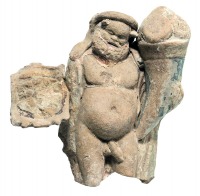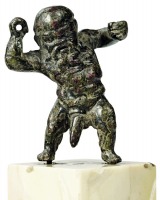A topsy-turvy world - the grotesque
Highlighted Works of Art - 2013 Summer
Two fundamental types of representing the human body were contrasted by Mikhail Bakhtin, an outstanding 20th-century Russian theorist and scholar. One is the classical body (perfection closed within itself); the other is the grotesque, open to the outside world and existing in continuous blending and interaction with it.
It is not only the outside world that invades the grotesque body (this is what makes eating, drinking and love-making so important in literary representations of the grotesque).
 |
| 4 |
The body also penetrates the outside world with exaggerated features like a large nose, stomach, buttocks, phallus or hump. (
1-4)The classical body is timeless, while the grotesque body is in a state of decay and regeneration. Although the closed classical body is not motionless or static, its boundaries are well defined. This relates to the culture of seriousness, while the grotesque body rules over the world of laughter.
 |
| 1 |
The grotesque as an aesthetic quality was born in the 16th century. It was named after the Italian word grotta 'cave', after a mode of representation observed on frescoes in Nero’s buried, (hence cave-like) palace, which show the human body and floral ornamentation, elements of different origin, as though blurred and transforming into one another. But irrespective of the name, the tradition of grotesque representation that questioned the closedness and integrity of the classical body in the Bakthinian sense was essentially continuous in European culture from antiquity to at least the end of the Renaissance.
 |
| 5 |
The portraits (
3) in the engraving of Wenzel Hollar (1607-1677) exhibited here (
5), made after a drawing of Leonardo da Vinci, show the same exaggerated features as the Hellenistic terracottas. In the series of engravings (
6) by Jacques Callot, French graphic artist (1592-1635), the world of carnivals and fairs, the most important realm of the Bakhtinian grotesque, comes to life. The dancers who appear in pairs before an audience composed of the fairground crowd perform a dance called the sfessania, which originally symbolized the fight between Christians and Moors. The "warriors" wearing tight costumes and feathered hats, and the "clowns" in loose-fitting garments and hats with enormous rims, provoke each other with violent and obscene gestures, painfully twisting their bodies, "fighting" with swords and even lutes in order to entertain the public.
 |
| 6a |
By the end of the 18th century, as modern European culture assumed a more serious air, the romantic grotesque lost its liberating quality of universal ridicule and became sombre, threatening and ghastly. It is in this sense that the word grotesque became generally accepted in classical archaeology (since the formation of the field itself also dates to this period). The 'grotesque’ ceased to refer to the ridiculous and playful (this became caricature), now denoting what was simply hideous and deformed.
 |
| 7 |
In the Hellenistic Period of Greek art (3rd-1st c. BC) the significance of the grotesque representation of the body rose to a previously unprecedented degree. The Hellenistic grotesque, with its rejection of idealism and grubbing in realistic detail, was in some ways at least connected to earlier iconographic types such as the potbellied Silenus (
7) or the satyr, whose animal attributes question the integrity of the human form: both mythological creatures who belonged in the sphere of Dionysus, the god whose task it originally was to overturn the world of seriousness and introduce an element of carnival to human existence. Some representations showing deformed, abnormal figures instead of the classical, ideal human body predate the Hellenistic Period. Dancers or revellers in padded costumes appear on Corinthian black-figure vases around 630 BC. These resemble to a great extent the actors who performed the later Old Comedy (c. 486-400 BC) of poets like Aristophanes, who appear on South Italian vases from the 4th century wearing short, padded chitons with a grotesque mask and a large phallus.
 |
| 9-11 |
The padded banqueteers, however, still lack the grotesque mask. Another significant group of early caricatures was discovered in the Kabirion near Thebes in Boeotia. In the sanctuary of Kabirus, who was similar in appearance to Dionysus and Pais ("the Boy"), who was represented as a cup-bearer, a number of black-figure drinking cups were found (dating to the period between the second half of the 5th and the first half of the 4th centuries BC) which show potbellied figures with caricaturistic features and large phalloi together with pygmies and banqueteers.
 |
| 12 |
But the par excellence genre of the grotesque in ancient art is Hellenistic terracotta sculpture. The majority of these are fragments of heads; the necks of the statuettes were easily damaged when buried in the ground, but the "nicer-looking" (and therefore easier to sell) heads were also often broken off by looters who simply discarded the bodies. The ambiguity of the grotesque is perfectly expressed in the statues of pregnant old women, also mentioned by Bakhtin: the body approaching its end but also foreshadowing the presence of a new body to be born. The old woman on display at the exhibition is even pulling up her dress (
8); instead of signifying old age, the body thus disposed becomes a symbol of fertility. There have been many attempts by classical scholars at interpreting these objects. Why did people make statuettes of ugly human bodies? Why were they not content with the idealized beauty created precisely by the Greeks? Who needed statuettes of cripples, dwarfs or the sick?
 |
| 14 |
One theory holds that the representations of bodily deformations served as tools in teaching medicine(
9-11); others think the objects were votive gifts by the sick. Some of the dwarfs and the cripples are obviously shown in the act of dancing, which may be a realistic representation of city life (street entertainers or beggars), or it may also point to a connection with some festival or rite, and thus to the cultic sphere - the wreaths crowning their heads (
12-13) possibly serving as an indication.
 |
| 15 |
The exhibited bronze dwarf, which dates to the early Imperial Period (
8) is not, however, an everyday figure, but one of the mythical Pygmies, a people in Africa who were represented from the Archaic Period most frequently in the act of fighting the cranes. Considering the figure’s warlike stance, the drilled hands must have originally held some kind of weapon, the left perhaps a shield. The caricatured, exaggerated features are also at home in the theatre. The mask (
15) may have a similar effect to that of a deformed head(
16); some unmasked statuettes in unnatural gestures may suggest actors in the theatrical genre known as 'mime', since characters in this type of drama, established in the Classical Period appeared in everyday clothes and without masks.
Some of the terracottas may be portraits of actors or the counterparts of characteristic figures of comic drama sold as theatre souvenirs. The world of the ancient theatre, however, offered far more than profane entertainment, since from the outset it was connected to the cultic sphere.
The group of grotesque statuettes unearthed as tomb equipment may also be related to the god Dionysus. To initiates into his mystery cults, some of which can be traced back to classical times, this deity, who died but was restored to life, promised happiness after death. The statuettes discovered in cemeteries and houses both presumably served as apotropaic amulets - proof being provided by the suspension ring or hole present on several statues (
17-18)- since what is hideous may in itself frighten away harmful forces.
Péter Hajdu / Eszter Süvegh
We are grateful for the support of Napfolt Ltd.













